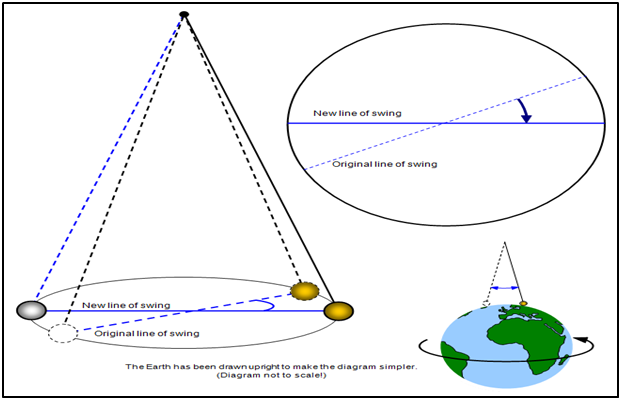Why in News?
- A Foucault pendulum that rotates on its axis is suspended from the ceiling of the entrance hall of the Constitution Hall of India's new Parliament building, signifying the integration of the idea of India with the idea of the cosmos.
- Created by the National Council of Science Museum (NCSM, Kolkata), the pendulum is being dubbed as the largest such piece (22 m in height, and 36 kg in weight ) in India.
What’s in Today’s Article?
- What is a Foucault’s Pendulum?
- Working of a Foucault’s Pendulum
- Time to Change Orientation at Different Latitudes
- News Summary Regarding Foucault’s Pendulum at new Parliament Building
What is a Foucault’s Pendulum?
- The original Foucault’s pendulum, named after 19th century French physicist Leon Foucault, is a simple experiment to demonstrate earth’s rotation.
- When Foucault carried out this experiment for the public in 1851, it was the first direct visual evidence of the fact that the earth rotates on its axis.
- The experimental set-up involves a heavy object hung from a height with a string, free to swing in any direction.
- Once set in to-and-fro motion, the pendulum is seen to change its orientation slowly over time.
- For example, if the initial motion imparted to it was in the north-south direction, after a few hours it could be seen moving in the east-west direction.
Working of a Foucault’s Pendulum:
- According to Newton's First Law of motion, every object will remain in uniform motion in a straight line unless compelled to change its state by the action of an external force.
- Thus, when a pendulum is set to swing it will continue to swing in the same direction unless it is pushed or pulled in some other direction.
- The earth, on the other hand, will rotate once every 24 hours underneath the pendulum.
- This means, if one stands to watch the pendulum, s/he would be likely to notice that the line of the pendulum's swing has changed to a different direction.
- This is because observers too are rotating with the earth, but can notice the change in orientation of the pendulum.

Time to Change Orientation at Different Latitudes:
- At the equator, the pendulum is perpendicular to the axis of rotation, and hence it never changes its orientation of the swing.
- At other latitudes, it will, and would return to the original course after fixed time periods.
- At the north and south poles, when the pendulum is aligned with the axis of rotation of the earth, the pendulum’s back-and-forth motion comes back to its original plane in exactly 24 hours.
- At other latitudes (because the pendulum is not aligned to the axis of rotation of the earth), it takes longer for the pendulum to return to its original orientation of swinging.
News Summary Regarding Foucault’s Pendulum at new Parliament Building:
- Pendulum at the new Parliament:
- All the components of the pendulum have been completely made in India.
- The piece, made using gunmetal, has been fixed with an electromagnetic coil to ensure hassle-free movement.
- The suspension system is mounted on the ceiling. There is continuous power supply so there are no obstacles (to the pendulum’s movement).
- At the latitude of the Parliament, it takes 49 hours, 59 minutes, and 18 seconds for the pendulum to complete one rotation.
- Significance: It is a piece reflecting the spirit of Article 51A of the Indian Constitution, which enshrines every citizen “to develop the scientific temper, humanism, and the spirit of inquiry and reform”.
- The first such pendulum: It was installed in 1991 at the Inter-University Centre for Astronomy and Astrophysics (IUCAA) in Pune.










